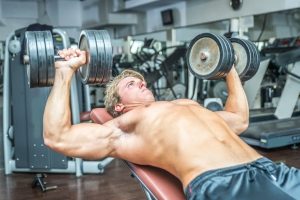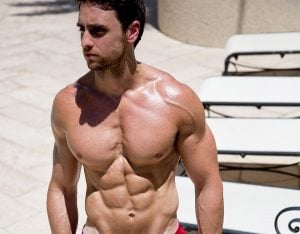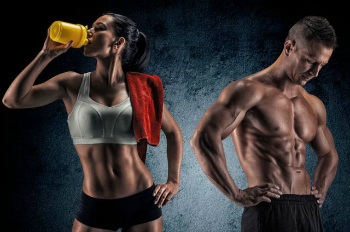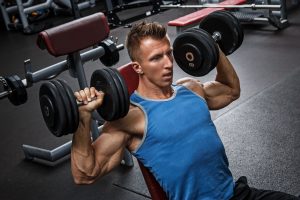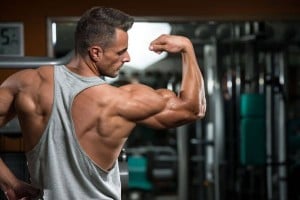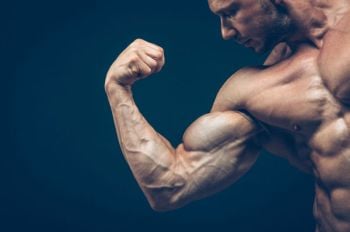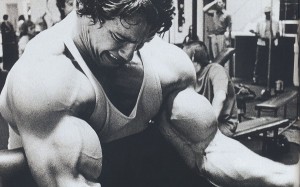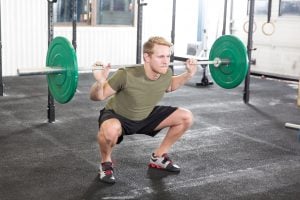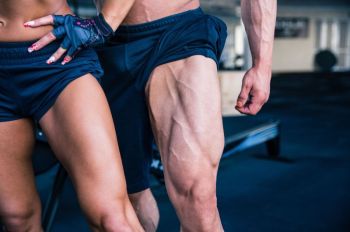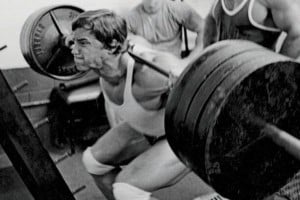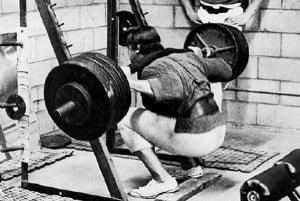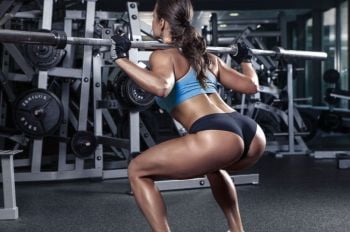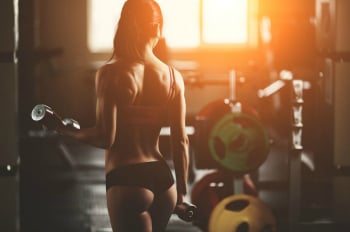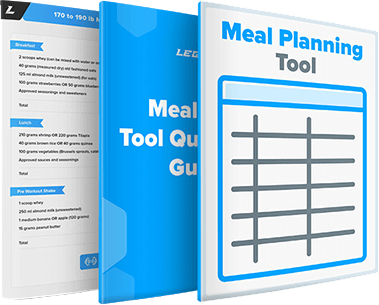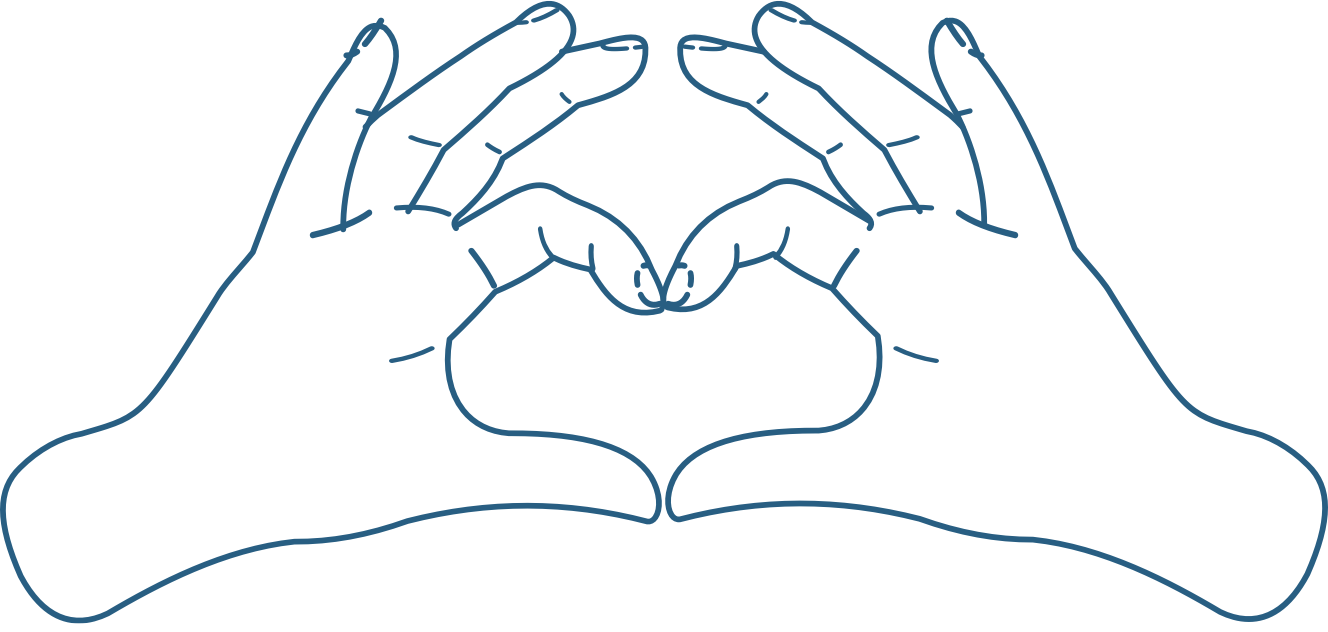Key Takeaways
- Your shoulders are comprised of three major muscles known as the anterior (front) deltoid, the lateral (side) deltoid, and the posterior (back) deltoid.
- The best shoulder exercises are pushing movements that allow you to safely move heavy loads and best improve your shoulder strength.
- The best way to build your shoulders is to get as strong as possible on a handful of key exercises, including the barbell and dumbbell overhead press, the dumbbell side raise, and the Arnold press.
Let’s face it:
An upper body just isn’t complete without well-developed shoulders.
It doesn’t matter how big your arms, chest, or back is, or even how swole your legs and calves are.
If you don’t have big, strong, defined delts, there’s always something missing from “the look” that most weightlifters are after.
This is especially apparent when your clothes are on, as well-developed shoulders make a significant difference in how wide your upper body (and small your waist) appears.
For example, check out this picture of Greg Plitt, who had one of the greatest physiques I’ve ever seen:
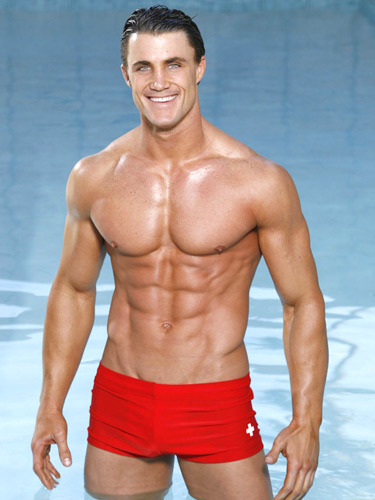
Great chest, great traps, good lats, freaking awesome abs, but his shoulders are lacking. He knew that, though, and after several years of work, here’s what he had to show for it:
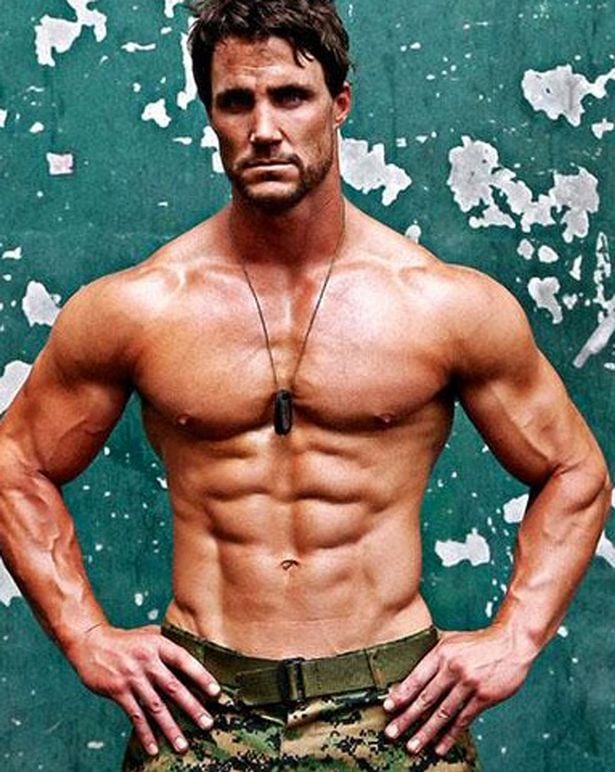
#lifegoals 😉
Now, if you’re reading this article, I probably don’t have to convince you to build bigger, stronger shoulders.
You’re sold. You just need to know how.
I bet you’ve tried, too. You’ve likely poured who knows how many hours of time and gallons of sweat into your delts only to be disappointed. Or worse, injured.
The reality is anyone who says building impressive shoulders is easy is lying. It takes a lot of work—the right work—and patience.
BUT it can be done.
And this article is going to show you how.
You’re going to learn . . .
- What shoulder muscles you most want to train
- The three biggest mistakes people make in their shoulder workouts
- The three most important principles of effective shoulder training
- The absolute best shoulder exercises you can do (it’s a surprisingly short list!)
- My favorite barbell and dumbbell shoulder workouts
- And more . . .
Let’s start with a review of the basic anatomy and then get into how to gain shoulder size and strength.
Table of Contents
+
Would you rather watch a video? Click the play button below!
Want to watch more stuff like this? Check out my YouTube channel!
Understanding Shoulder Anatomy
Your shoulders are comprised of three major muscles known as deltoids, and here’s how they look:
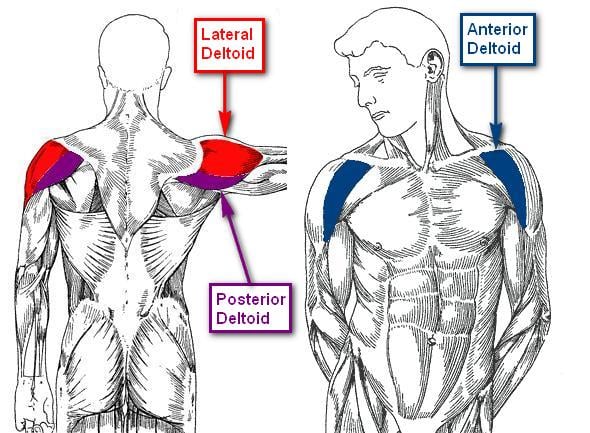
It’s very important to develop all three heads (portions) of this muscle, because if one is lagging, it will be painfully obvious.
In most cases, the lateral and posterior deltoids need the most work because the anterior deltoids do get trained to some degree in a good chest workout, and nobody skips chest day. Chest training doesn’t adequately train the other two deltoid heads though.
Let’s use my own physique as an example.
First, check out the following picture taken about 7 years ago, before I knew what I was doing with my training and dieting:
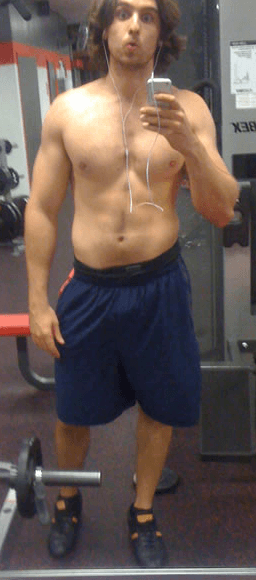
Look at my left shoulder and how small it is compared to the middle of my upper arm and how much it’s overpowered by my chest (as you can see, I never skipped chest day).
And let’s not talk about my calves.
I wasn’t neglecting my shoulders, either. I was doing quite a few sets of presses and raises every week as well as a significant amount of volume thanks to higher rep ranges and fancy fancy training techniques including drop sets, supersets, etc., and so forth.
Soon after I took that picture, however, I threw away the muscle mags and began truly educating myself on how to build muscle and strength and lose fat.
After making dramatic changes to my diet and training routines based on what I had learned (which I share in my books for men and women), things starting moving in the right direction:

Quite an improvement in my shoulders and overall physique (I was thrilled), but let’s focus again on that left shoulder because it’s still lagging. Specifically, the lateral head lacked size and didn’t protrude enough to balance the size of my biceps and triceps.
I kept working at it, however, and here’s a shot of me taken a couple years later:
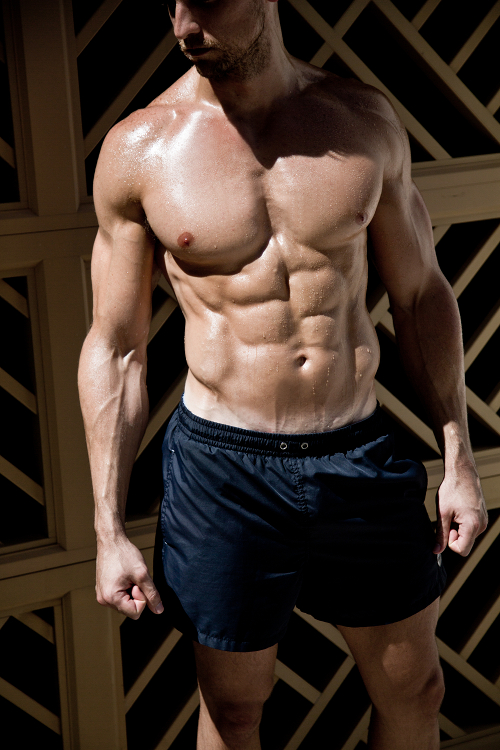
Mucho bettero, no?
And here’s where I’m at now:
View this post on Instagram
My shoulders may not be able to earn any distinction in a bodybuilding contest, but I think you’ll agree they’ve greatly improved over the years and are now fairly proportional to my arms, chest, and back.
Although it has taken me longer to get here than it should’ve, my progress illustrates another important point: it takes most people years of proper training to get shoulders that look proportionate to their arms and chests.
And especially if their arms or chests are high responders (like mine have been).
There are some genetic freaks out there who have naturally large shoulders, but most everyone I know who’s spent any time lifting weights has struggled with lagging shoulders.
That doesn’t mean you can’t get the shoulders you want, however. Let’s find out how.
The 3 Biggest Mistakes of Shoulder Training
The three biggest mistakes most people make in their shoulder workouts are:
- Focusing on the wrong shoulder exercises.
- Focusing on high-rep training.
- Neglecting progressive overload.
Let’s go over each one.
Mistake #1: Focusing On the Wrong Shoulder Exercises
Many people focus too much on machines and isolation exercises, which are of secondary importance in building big, strong, round delts.
A common misconception is that because the shoulders are a smaller muscle group, they respond best to exercises that only work the shoulder muscles. In other words, isolation exercises.
While this makes sense on paper, it presents a serious problem:
Due to the way your body is built, you can’t safely move as much weight with an isolation exercise like the cable side raise or dumbbell front raises as you can with a compound exercise like the overhead barbell press or Arnold press.
For example, it’s not uncommon for a guy new to weightlifting to start out overhead pressing just the bar, and within a year, put up 135 for reps. On the other hand, could that same guy add nearly 100 pounds to his front raise in a year? No way, no how.
Sadly there’s scant scientific evidence on the best shoulder exercises for muscle growth, but we do have one unofficial study conducted by a pair of German scientists named Buskies and Boeck-Behrens.
They had ten 22-year old men perform seven shoulder exercises after hooking them up to electrodes to measure the level of muscle activation in their deltoids.
Unfortunately, I haven’t been able to find details on how much weight the subjects used, but normally in studies like these, they use a percent of their one-rep max for all of the exercises. For example, they’d use 90% of their one-rep max for all exercises until muscle failure, or the point where they can’t do any more reps while maintaining good form.
Anyway, the key findings were that the overhead press caused the highest levels of muscle activation in the front delt—41% more than dumbbell side raises.
The lateral raise produced the highest levels of muscle activation in the side delt.
And the machine reverse fly produced the highest levels of muscle activation in the rear delt.
Here’s what the results looked like:

It’s not worth getting too excited about this study as it only included 10 people, hasn’t been published in an official, peer-reviewed journal, and it relied on muscle activation testing, which isn’t a perfect predictor of muscle growth. It’s just a clue that an exercise is probably effective for training a muscle, assuming you can keep adding weight over time.
That said, the findings line up nicely with anecdotal evidence as well.
I don’t know about you, but I’ve worked with thousands of guys over the years and have yet to see a single one get the shoulders they really wanted with just isolation exercises. Heavy pressing is always involved.
If we look at the people who can press the most—powerlifters—then it also becomes clear that doing boatloads of isolation exercises isn’t holding them back.
As this study and most experienced lifters will tell you, isolation exercises can work well if you want to target a particular part of your shoulder (like the rear delt), but they should never be the primary focus of your shoulder workouts.
If you want to build bigger, stronger, rounder shoulders, then you want your shoulder workouts to focus on big, compound exercises like the barbell and dumbbell overhead press, with less time spent on isolation exercises like front and side raises.
Mistake #2: Focusing On High-Rep “Pump” Training
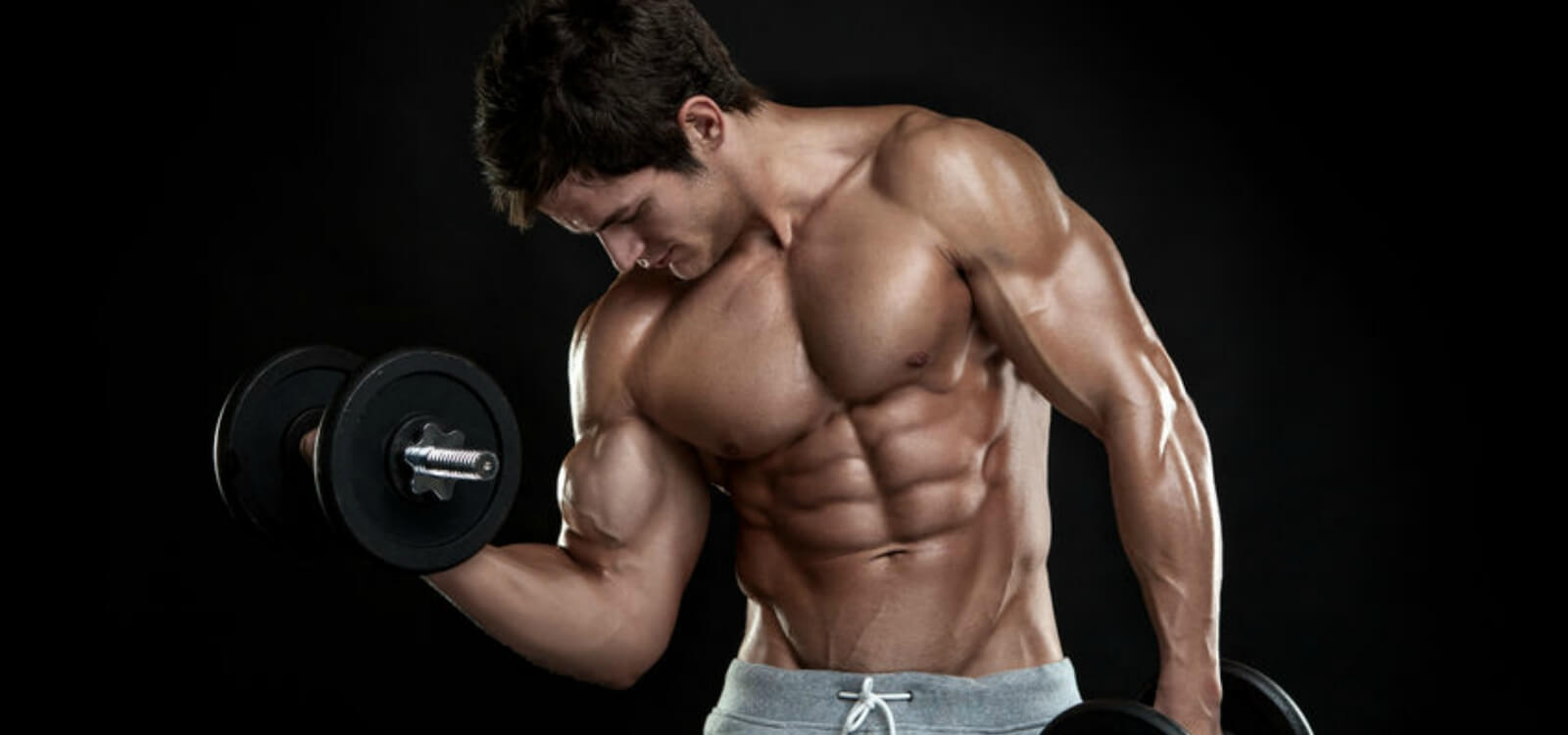
This mistake will stunt the growth of every major muscle group in the body and is particularly detrimental in a smaller muscle group like the shoulders.
The reason for this is that one of the best ways to make the pecs (and other muscles) grow is to use heavier weights.
For example, in a study conducted by scientists at Lehman College, 24 physically active, resistance-trained men were split into two groups:
- Group one did three workouts per week consisting of 21 sets per workout in the 8-to-12-rep range with 70 to 80 percent of their 1RM.
- Group two did three workouts per week consisting of 21 sets per workout in the 25-to-35-rep range with 30 to 50 percent of their 1RM.
Both groups did the same exercises, which included the barbell bench press, barbell overhead press, wide-grip lat pulldown, seated cable row, barbell back squat, machine leg press, and machine leg extension. Both groups were also instructed to maintain their normal eating habits and keep food diaries.
After eight weeks of training, the researchers found that while both groups gained about the same amount of muscle, the first group gained significantly more strength than the second group.
Specifically, group one increased their bench press 1RM by 10 pounds—good progress for intermediate lifters—whereas the second group didn’t improve their strength to any significant degree.
As I mentioned, muscle gain was more or less the same over these eight weeks, but it’s very likely that the first group would gain more muscle over time as they continued to get stronger.
This is because as you get closer to your genetic limit for muscle growth, gaining strength becomes more and more important for gaining muscle.
What’s more, in order to gain a significant amount of muscle with higher reps, you have to take each set to or close to muscular failure (the point where you can no longer keep the weight moving).
This can be done, of course, but it’s extremely difficult.
If you want to get a taste of what it’s like, do a 20-rep set of barbell bench press that ends a rep or two shy of muscle failure. And then imagine having to do a couple more sets, and then having to do it all again in a few days. And then keep that up for months on end.
Fortunately, you don’t need to do that because you can simply train with heavier weights, which is equally (if not more) effective for muscle gain, and far less grueling.
This is why the shoulder workouts you’re going to learn how to do below focus on heavy, lower-rep lifting, with a few sets of higher-rep lifting for exercises that don’t lend themselves as well to lower reps.
Mistake #3: Neglecting Progressive Overload
The first, second, and third commandment of getting bigger and stronger shoulders is this: thou shalt progressively overload thy muscles.
If you don’t get this right, then you’re always going to struggle to develop your shoulders (and every other muscle group, for that matter).
Progressive overload refers to increasing the amount of tension your muscles produce over time, and the most effective way to do this is by progressively increasing the amount of weight that you’re lifting.
In other words, the key to gaining muscle and strength isn’t doing different exercises, balancing on a BOSU ball, or seeing how much you can sweat on everything in the gym—it’s making your muscles work harder. And this is exactly what you do when you force your muscles to handle heavier and heavier weights.
Your number one goal as a weightlifter should be to increase your whole-body strength over tim e, and the program you’re going to find at the end of this article is built to accomplish exactly that.
The Simple Science of Effective Shoulder Training
You can build a great set of shoulders without drugs. It just takes a bit of know-how, hard work, and patience. The strategy is simple enough:
- Target the front, side, and rear delts.
- Do compound exercises and lift heavy weights.
- Do one to three shoulder workouts per week.
Let’s look at each part of this plan.
1. Target the Front, Side, and Rear Delts
As you learned a moment ago, you should primarily emphasize the side and rear delts in your workouts, as your front delts already get plenty of attention in your chest workouts.
As the data from the two German scientists showed (as has other research), the front delts take a serious beating during all pressing exercises. This is particularly true of the bench press and incline bench press.
Thus, if you’re already bench pressing a few times per week, you’re also training your front delts a few times per week.
This is why I recommend that you primarily focus on exercises that target your side and rear delts in your shoulder workouts.
Here are the tactics that I use and recommend to target all parts of your shoulders:
- Bench and incline press two to three times per week to train your front delts. You’re probably doing this already, but it’s worth reiterating.
- Include exercises that involve both shoulder abduction (such as a side lateral raise) and extension (such as a reverse fly). This ensures you train both your side and rear delts.
- Train with heavy weights, because research shows that it increases muscle activation of all three portions of your deltoids.
The workout program I share in this article incorporates each of these tips.
2. Do Compound Exercises and Lift Heavy Weights

I used to think that heavy, lower-rep lifting was for building strength, not gaining size. I was wrong.
One of the most important lessons I’ve learned in the last decade of researching, training, and coaching is this:
As a natural weightlifter, your number one long-term goal should be increasing your whole-body strength.
I know, I’m repeating myself, but it bears repeating because it’s just that important. So long as you make that your primary focus in your training, you’ll have no trouble gaining size and definition.
The reason for this is while you can gain a fair amount of muscle in the beginning without gaining much strength, once you graduate to an intermediate lifter (year 2+), strength and size become closely correlated.
In other words, once your “honeymoon phase” is over and your body is no longer hyper-responsive to resistance training, the best way to continue gaining size is to continue gaining strength.
How do you best do that?
While exercise science is complex and there are many more questions than answers, the evidence is clear on this one: Heavy, compound resistance training is the most effective way to get stronger.
And that’s why us natural weightlifters need to do a lot of heavy compound weightlifting if we want to gain significant amounts of muscle and strength.
This isn’t a special rule just for the shoulders, either. It applies equally to every major muscle group in the body, including the smaller, more stubborn ones like the arms, calves, and chest, as well as the bigger, more responsive ones like the legs and back.
Therefore, if you want to get a big, rounded, or even just “defined” shoulders as quickly as possible, then you want to get strong shoulders as quickly as possible, and that means doing a lot of heavy shoulder training.
And that mostly means a lot of heavy pressing.
What do I mean by “heavy,” you’re wondering?
I mean working primarily with weights in the range of 70 to 80% of your 1RM, or in the range of 8 to 10 (70%) to 4 to 6 (80%) reps.
Practically speaking, this means taking each set to about one to two reps shy of technical failure (the point at which you can’t complete another rep without a breakdown in form). Another way of looking at this is finishing each set with one to two “reps in reserve,” as researchers call it.
In other words, your “muscle-building sets” should be pretty damn hard.
What do I mean by “compound” exercises?
Well, these are exercises that involve multiple joints and muscles, as opposed to isolation exercises that focus on a single joint and a limited number of muscles.
For example, an isolation exercise like the dumbbell side raise primarily involves the shoulder joint and the traps, whereas a compound exercise like the barbell overhead press involves the shoulder and elbow joints and the pecs, deltoids, triceps, back, and even the legs to a slight degree.
“But wait a minute,” you might be thinking. “[SHREDDED FITNESS MODEL] does a billion reps in his shoulder workouts and has boulder-shoulders . . . What gives?”
Unfortunately, steroid use is rampant in this space, and especially among fitness competitors, models, and social media influencers, and these drugs change everything.
With the right drugs, you can just sit in the gym for a few hours every day doing set after set, exercise after exercise, and your muscles will just get bigger and bigger. (A bit of reductive, I know, but more accurate than inaccurate.)
For example, one study conducted by scientists at the Charles R. Drew University of Medicine and Science gave a relatively small dosage of testosterone (600 mg per week) to one group of weightlifters and a placebo to another group for 10 weeks.
In the end, the natty group gained 4.4 pounds of muscle and added 22 pounds to their bench, which is good progress for intermediate lifters.
Those on the #dedication, however, gained a whopping 13.4 pounds of muscle and added 50 pounds to their bench and eight times as much size in their triceps. In 10 freaking weeks. That’s toddler-on-bath-salts crazy.
Don’t worry, though.
You don’t need drugs to build a set of shoulders you can be proud of. You just need a bit of know-how, hard work, and patience.
3. Do One to Three Shoulder Workouts Per Week
You may have heard that you need to train each muscle group at least two or three times per week to maximize muscle and strength gain.
This advice is on the right track, but is also missing the forest for the trees.
Research shows that workout frequency per se, or how often you train a particular muscle group, actually isn’t all that important when it comes to gaining muscle and strength.
What matters much more is your total weekly training volume, or the total amount of hard sets you do each week.
“Hard sets?” you’re wondering.
Well, as you know, a “set” is a fixed number of repetitions of a particular exercise, and a “hard set” is a heavy, muscle- and strength-building set that’s taken close to technical failure (the point where you can no longer continue with proper form).
So, coming back to my point above, as long as you do enough hard sets each week for a given muscle group, it doesn’t matter much how you break them down into individual workouts.
For example, you can expect more or less the same amount of muscle and strength gains from doing 12 hard sets for your shoulders on Monday or doing 4 hard sets for your shoulders on Monday, Wednesday, and Friday.
With that out of the way, let’s get to the obvious question: How many hard sets should you do per week to build great shoulders?
I’ve tried many different workout splits and volume and frequency schemes and what I’ve found works best is in line two extensive reviews on the subject.
When your training emphasizes heavy weights—70 to 80%+ of 1RM—optimal volume seems to be about 9 to 15 hard sets performed every 5 to 7 days.
This applies to the shoulders as well as every other major muscle group.
Before you increase your training volume or your frequency beyond that, make sure you’re pushing for progressive overload in your workouts, getting enough sleep, and eating enough food.
In many cases, people I’ve worked with who thought they were “hardgainers” who needed loads of volume to make gains were really just people who needed to train harder, get more sleep, or eat more food.
That said, now and then, I do hear from people (guys, mostly) who appear to be doing everything right but simply aren’t seeing significant changes in their shoulder size and strength.
And here’s what I like to do with them:
- Train shoulders two or three times per week on nonconsecutive days.
- Increase the number of weekly hard sets to 18 to 27.
For example, if they’re currently training shoulders on Mondays and Thursdays, I’d have them reshuffle their schedule so they can train shoulders on Mondays, Wednesdays, and Fridays (remember, this is including chest workouts, which also train the shoulders).
This slight increase in weekly volume isn’t a “magic fix” by any means, but can help break through stubborn muscle growth plateaus.
Alright, now that we have basic training theory under our belts, let’s look at the 10 best shoulder exercises.
The Best Shoulder Exercises
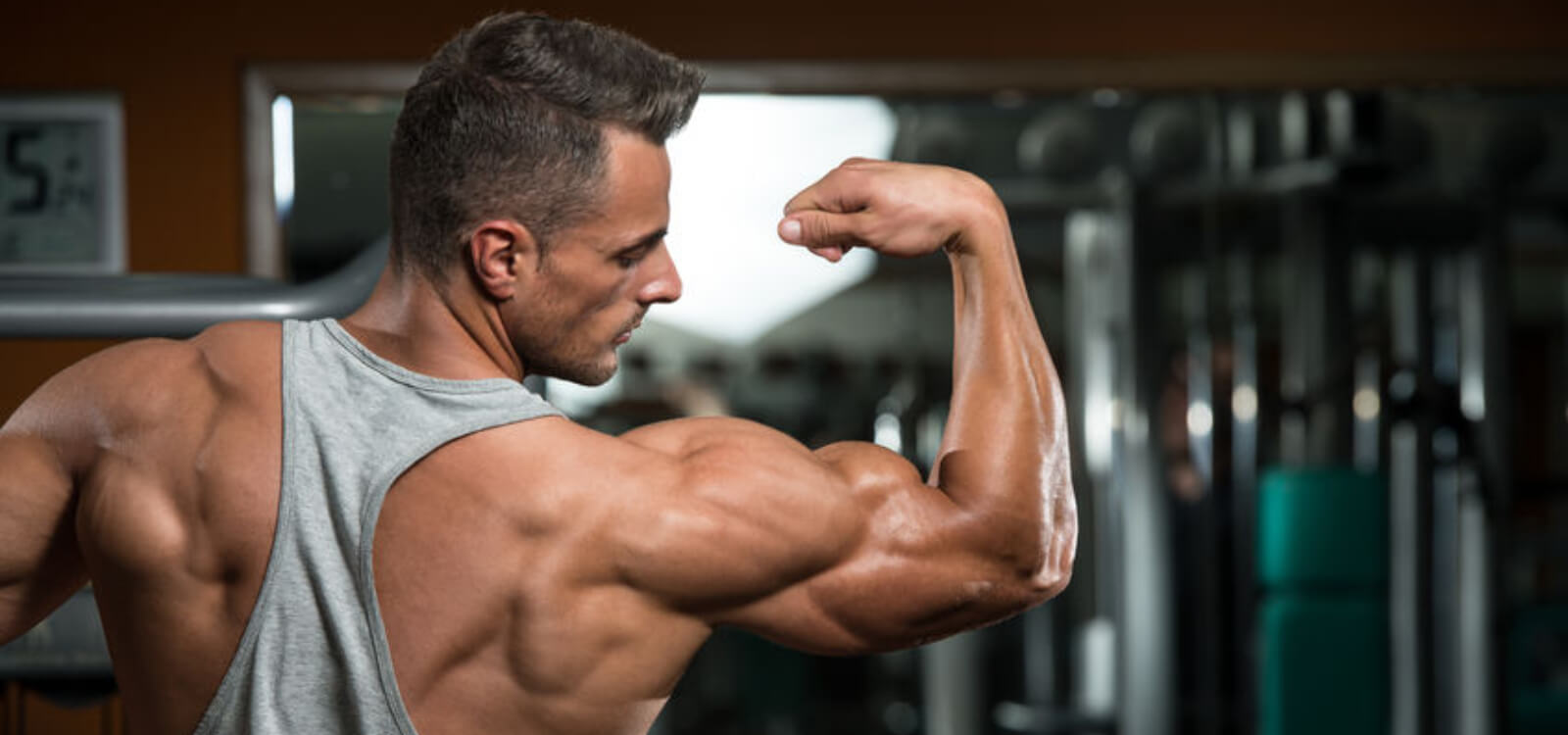
Like with most muscle groups, there are scores of shoulder exercises you can choose from but only a small handful are really necessary.
These are the exercises I’ve used to dramatically improve my shoulders. They will help you do the same.
1. Seated or Standing Overhead Press
Barbell and dumbbell pressing is the most effective way to build your shoulders because although it focuses on the anterior head of the deltoid, it also involves the other two, and it allows you to push heavy weight without risking a shoulder injury.
EMG research has shown that dumbbell pressing may activate the shoulder muscles slightly more than barbell pressing, but the effects seen were small and EMG data isn’t exactly rock solid.
Practically speaking, I wouldn’t say the dumbbell overhead press is better than the barbell press or vice versa.
Like the bench press, I’ve found dumbbell and barbell pressing to be complementary and have included both in my workout routines for some time now. Both require strength and stability and both produce good results, and I recommend you alternate between them.
What I like to do is 6 to 8 weeks of heavy barbell pressing followed by 6 to 8 weeks of heavy dumbbell pressing.
Now, there are two variations of the overhead press–standing and seated.
Give them a try and you’ll quickly learn that the standing overhead press is significantly harder than the seated. And harder usually means better.
The same EMG study I cited earlier supports this, showing that the standing presses (both dumbbell and barbell) activated the shoulder muscles slightly more than their seated counterparts.
Furthermore, many well-informed fitness experts say the standing barbell press is the superior choice and I don’t necessarily disagree. In terms of whole-body training, there’s no question that the standing press is superior.
That said, there are three drawbacks to the standing overhead press that you should be aware of:
- Your 1RM will be lower.
- You have to be more careful when you’re trying to move heavy weights (80%+ of 1RM).
- You have to take more time to learn how to do standing overhead press correctly than you do to do the seated version.
You see, the standing press places a lot more stress on the lower back and core than the seated press, which means you won’t be able to lift as much weight and you’ll be at a higher risk of injury if your form is sloppy.
These disadvantages are especially true with the standing dumbbell press, which really doesn’t lend itself to heavy pressing.
This makes the standing overhead press a better whole-body exercise, but if you’re trying to maximally overload your shoulders, the seated overhead press allows you to “target” your shoulders with heavier weights.
My personal preference is the seated overhead press (barbell and dumbbell) because I feel that my heavy deadlifting and squatting is more than enough for my core and back.
That said, I do like to alternate between standing (barbell) and seated (dumbbell and barbell) overhead pressing.
Here’s how to properly do the seated barbell overhead press:
And here’s the dumbbell press:
Here’s how to do the standing barbell overhead press correctly:
And the standing dumbbell press:
2. Arnold Press
The Arnold press is a variation of the traditional dumbbell press that increases the range of motion.
Here’s how to do it:
3. Dumbbell Front Raise
The dumbbell front raise is an effective exercise for targeting the anterior deltoid.
Here’s how to do it:
4. Dumbbell Side Lateral Raise
The dumbbell side lateral raise is the most effective exercise for building the lateral deltoid, which needs targeted work to keep up with the anterior head. Pressing alone won’t get the job done.
Here’s how to do it:
As your shoulders get stronger, you’ll find it harder to maintain proper form when trying to lift both dumbbells simultaneously.
An effective way to get around this without cheating is to do a hanging variant of the exercise:
5. Dumbbell Rear Lateral Raise
The posterior (rear) deltoid is the smallest and weakest of the three heads of the shoulders, but it shouldn’t be neglected.
If you want “three-dimensional” shoulders that don’t fall completely flat in the back, you want to train your rear delts. And the dumbbell rear lateral raise is a great exercise for this.
Here’s how to do it:
You can also do a standing variation of this exercise:
6. Barbell Rear Delt Row
The barbell rear lateral row is another great exercise for targeting the posterior deltoids. Here’s how to do it:
7. Face Pull
The face pull is a great exercise for strengthening both the posterior deltoids and the rotator cuff muscles.
Here’s how it’s done:
8. Flat and Incline Barbell Bench Press
The barbell bench press is usually considered a chest exercise, but research shows it’s also quite effective for building your shoulders.
Here’s how to do it:
The incline version also preferentially trains the shoulders, too. Here’s how to do it:
And if you want to learn the finer points of how to flat and incline bench press with proper form, check out this article:
The Definitive Guide on How to Bench Press (and the 8 Best Variations!)
Remember–Progression Is the Key to Muscle Growth
That’s it on the exercises. Out of all the dozens and dozens you could do, these eight are all you need to build strong, full, and functional shoulders.
The key, however, isn’t just doing the above exercises. It’s progressing on them. That is, increasing the amount of weight you can handle over time.
Remember that as a natural weightlifter looking to get bigger, you must focus on getting stronger.
The 3 Best Shoulder Workout Routines
The following workouts check each of the important boxes for effective shoulder training:
- They use compound and isolation exercises to adequately train all three deltoids
- They involve a lot of heavy lifting
- They focus on progressive overload
Now, before we get into the routines themselves, let’s touch on an important programming point:
As all pressing exercises train the shoulders, you need to consider when you train your chest when programming for your shoulders.
For example, if you’re already training your chest twice per week (and thus your shoulders, too), doing another two shoulders shoulder workouts per week would be too much.
That’s why I consider all pressing workouts to also be shoulder workouts for programming purposes, and then schedule my dedicated shoulder workouts accordingly.
What this means is that if you’re already training your chest twice per week, as you do in my Bigger Leaner Stronger program for men, you don’t want to do more than one additional shoulder workout per week.
If, however, you’re only training your chest once per week and really want to focus on growing your shoulders, you can probably get away with two additional shoulder workouts per week.
To keep things simple, however, the workout routines I share below work for training both your chest and shoulders (with special emphasis on the shoulders).
So, depending on how often you’re going to train your chest in addition to these workouts, you can choose a one, two, or three day per week shoulder workout routine.
If you choose either the two or three day workout routine, make sure you put at least one or two days between the workouts (either by taking rest days or training other muscle groups).
Here are the workouts:
1 x Week Shoulder Workout Routine
Workout 1
Seated or Standing Barbell Overhead Press
Warmup and 3 hard sets of 4 to 6 reps at 80% of 1RM
3 hard sets of 4 to 6 reps at 80% of 1RM
Incline Dumbbell Bench Press
3 hard sets of 4 to 6 reps at 80% of 1RM
Dumbbell Rear Lateral Raise
3 hard sets of 4 to 6 reps at 80% of 1RM
2 x Week Shoulder Workout Routine
Workout 1
Barbell Bench Press
Warmup and 3 hard sets of 4 to 6 reps at 80% of 1RM
Seated Dumbbell Overhead Press
3 hard sets of 4 to 6 reps at 80% of 1RM
Dumbbell Side Lateral Raise
3 hard sets of 8 to 10 reps at 70% of 1RM
Face Pull
3 hard sets of 8 to 10 reps at 70% of 1RM
Workout 2
Seated or Standing Overhead Press
Warmup and 3 hard sets of 4 to 6 reps at 80% of 1RM
Arnold Press
3 hard sets of 4 to 6 reps at 80% of 1RM
Barbell Rear Delt Row
3 hard sets of 8 to 10 reps at 70% of 1RM
(Optional) Dumbbell Front Raise
3 hard sets of 8 to 10 reps at 70% of 1RM
3 x Week Shoulder Workout Routine
Workout 1
Barbell Bench Press
Warmup and 3 hard sets of 4 to 6 reps at 80% of 1RM
Seated Dumbbell Overhead Press
3 hard sets of 4 to 6 reps at 80% of 1RM
Dumbbell Rear Lateral Raise
3 hard sets of 8 to 10 reps at 70% of 1RM
(Optional) Face Pull
3 hard sets of 8 to 10 reps at 70% of 1RM
Workout 2
Seated or Standing Overhead Press
Warmup and 3 hard sets of 4 to 6 reps at 80% of 1RM
Arnold Press
3 hard sets of 4 to 6 reps at 80% of 1RM
Dumbbell Side Raise
3 hard sets of 8 to 10 reps at 70% of 1RM
(Optional) Dumbbell Front Raise
3 hard sets of 8 to 10 reps at 70% of 1RM
Workout 3
Incline Dumbbell Bench Press
Warmup and 3 hard sets of 4 to 6 reps at 80% of 1RM
Flat Bench Press
3 hard sets of 4 to 6 reps at 80% of 1RM
Dumbbell Rear Lateral Raise
3 hard sets of 8 to 10 reps at 70% of 1RM
(Optional) Dumbbell Rear Delt Row
3 hard sets of 8 to 10 reps at 70% of 1RM
If you’re new to strength training, the once-per-week shoulder routine is a great place to start. If you want to grow your shoulders as quickly as possible, however, or already have some strength training under your belt, give the twice- or thrice-per-week chest routine a go.
Also, a few odds and ends on how to do these workouts:
1. Once you hit the top of your rep range for one set, move up in weight.
This is known as “double-progression,” and it’s one of the most effective ways to ensure that you’re progressively overloading your muscles.
For instance, if you overhead press 6 reps for 135 pounds, add 5 pounds to each side of the bar for your next set.
If, on the next set, you can get at least 4 reps with 145 pounds, that’s the new weight you work with until you can overhead press it for 6 reps, move up, and so forth.
If you get 3 or fewer reps, though, reduce the weight added by 5 pounds (140 pounds) and see how the next set goes. If you still get 3 or fewer, reduce the weight to the original 6-rep load and work with that until you can do two 6-rep sets with it, and then increase.
2. Rest two to four minutes between each set.
The important thing is that you feel fully prepared to give your best on each subsequent set.
Yes, this is going to feel like a lot of standing around, but resting properly is an important part of heavy weightlifting.
This is the time where your muscles recoup their strength so you can give maximum effort each set.
Read this article to learn more.
3. Make sure you’re eating enough food.
You probably know that you’re supposed to eat a fair amount of protein to build muscle, but total calorie intake also plays a major role as well.
Read this article to learn more.
What About Supplements?

I saved this for last because, quite frankly, it’s far less important than proper diet and training.
You see, supplements don’t build great physiques–dedication to proper training and nutrition does.
Unfortunately, the workout supplement industry is plagued by pseudoscience, ridiculous hype, misleading advertising and endorsements, products full of junk ingredients, underdosing key ingredients, and many other shenanigans.
Most supplement companies produce cheap, junk products and try to dazzle you with ridiculous marketing claims, high-profile (and very expensive) endorsements, pseudo-scientific babble, fancy-sounding proprietary blends, and flashy packaging.
So, while workout supplements don’t play a vital role in building muscle and losing fat, and many are a complete waste of money . . . the right ones can help.
The truth of the matter is there are safe, natural substances that have been scientifically proven to deliver benefits such as increased strength, muscle endurance and growth, fat loss, and more.
As a part of my work, it’s been my job to know what these substances are, and find products with them that I can use myself and recommend to others.
Finding high-quality, effective, and fairly priced products has always been a struggle, though.
That’s why I took matters into my own hands and decided to create my own supplements. And not just another line of “me too” supplements–the exact formulations I myself have always wanted and wished others would create.
I won’t go into a whole spiel here though. If you want to learn more about my supplement line, check this out.
For the purpose of this article, let’s just quickly review the supplements that are going to help you get the most out of your shoulder (and other) workouts.
Creatine
Creatine is a substance found naturally in the body and in foods like red meat. It’s perhaps the most researched molecule in the world of sport supplements—the subject of hundreds of studies—and the consensus is very clear:
Supplementation with creatine helps . . .
You may have heard that creatine is bad for your kidneys, but these claims have been categorically and repeatedly disproven. In healthy subjects, creatine has been shown to have no harmful side effects, in both short- or long-term usage. People with kidney disease are not advised to supplement with creatine, however.
If you have healthy kidneys, I highly recommend that you supplement with creatine. It’s safe, cheap, and effective.
In terms of specific products, I use my own, of course, which is called Recharge.
Recharge is 100% naturally sweetened and flavored and each serving contains:
- 5 grams of creatine monohydrate
- 2100 milligrams of L-carnitine L-tartrate
- 10.8 milligrams of corosolic acid
This gives you the proven strength, size, and recovery benefits of creatine monohydrate plus the muscle repair and insulin sensitivity benefits of L-carnitine L-tartrate and corosolic acid.
So if you want to gain muscle and strength faster and recover better from your workouts, then you want to try Recharge today.
Protein Powder
You don’t need protein supplements to gain muscle, but, considering how much protein you need to eat every day to maximize muscle growth, getting all your protein from whole food can be impractical.
That’s the main reason I created (and use) a whey protein supplement. (There’s also evidence that whey protein is particularly good for your post-workout nutrition.)
Whey+ is 100% naturally sweetened and flavored whey isolate that is made from milk sourced from small dairy farms in Ireland, which are known for their exceptionally high-quality dairy.
I can confidently say that this is the creamiest, tastiest, healthiest all-natural whey protein powder you can find.
So if you want to try a 100% naturally sweetened and flavored whey isolate protein powder made from exceptionally high-quality milk that tastes and mixes great, then you want to try Whey+ today.
Pre-Workout Drink
There’s no question that a pre-workout supplement can get you fired up to get to work in the gym. There are downsides and potential risks, however.
Many pre-workout drinks are stuffed full of ineffective ingredients and/or minuscule dosages of otherwise good ingredients, making them little more than a few cheap stimulants with some “pixie dust” sprinkled in to make for a pretty label and convincing ad copy.
Many others don’t even have stimulants going for them and are just complete duds.
Others still are downright dangerous, like USPLabs’ popular pre-workout “Jack3d,” which contained a powerful (and now banned) stimulant known as DMAA.
Even worse was the popular pre-workout supplement “Craze,” which contained a chemical similar to methamphetamine.
The reality is it’s very hard to find a pre-workout supplement that’s light on stimulants but heavy on natural, safe, performance-enhancing ingredients like beta-alanine, betaine, and citrulline.
And that’s why I made my own pre-workout supplement. It’s called Pulse and it contains six of the most effective performance-enhancing ingredients available:
- Caffeine. Caffeine is good for more than the energy boost. It also increases muscle endurance and strength.
- Beta-Alanine. Beta-alanine is a naturally occurring amino acid that reduces exercise-induced fatigue, improves anaerobic exercise capacity, and can accelerate muscle growth.
- Citrulline Malate. Citrulline is an amino acid that improves muscle endurance, relieves muscle soreness, and improves aerobic performance.
- Betaine. Betaine is a compound found in plants like beets that improves muscle endurance, increases strength, and increases human growth hormone and insulin-like growth factor 1 production in response to acute exercise.
- Ornithine. Ornithine is an amino acid found in high amounts in dairy and meat that reduces fatigue in prolonged exercise and promotes lipid oxidation (the burning of fat for energy as opposed to carbohydrate or glycogen).
- Theanine. Theanine is an amino acid found primarily in tea that reduces the effects of mental and physical stress, increases the production of nitric oxide, which improves blood flow, and improves alertness, focus, attention, memory, mental task performance, and mood.
And what you won’t find in Pulse is equally special:
- No artificial sweeteners or flavors.
- No artificial food dyes.
- No unnecessary fillers, carbohydrate powders, or junk ingredients.
The bottom line is if you want to know what a pre-workout is supposed to feel like and want to experience the type of energy rush and performance boost that only clinically effective dosages of scientifically validated ingredients can deliver, then you want to try Pulse.
The Bottom Line on the Best Shoulder Workout
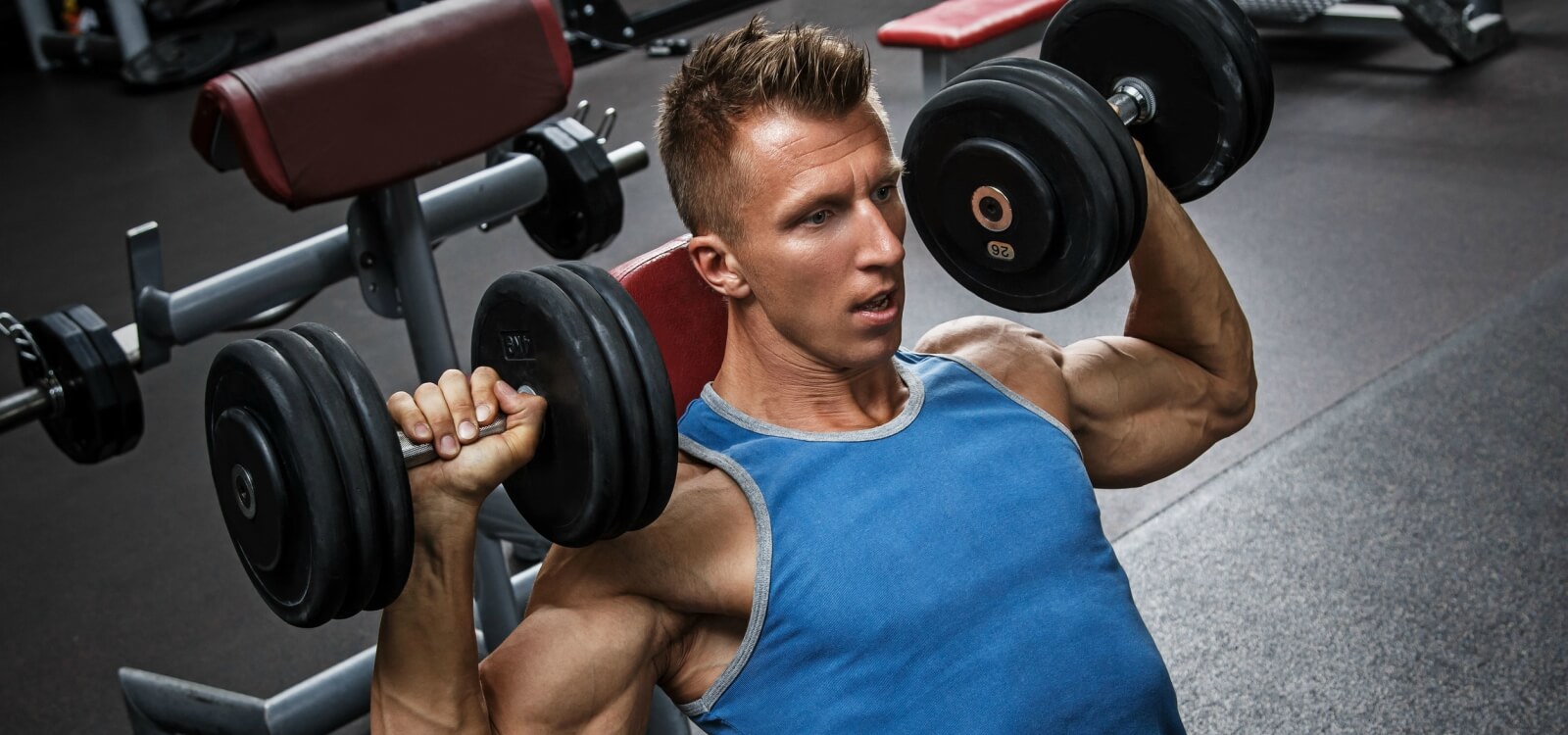
If you want to look jacked, you’re going to need big, strong, defined delts. And especially if you want to look jacked with clothes on.
Most weightlifters know this but fail to get the shoulders they really want mostly due to making one or more of the following mistakes:
- Focusing on the wrong shoulder exercises
- Focusing on high-rep training
- Neglecting progressive overload
And by the same token, you can basically guarantee good results by going in the other direction:
- Focusing on compound exercises and supplementing with isolation work
- Doing a lot of heavy lifting
- Ensuring you’re progressing over time
If you follow those principles, you can’t go wrong, and especially if you put most of your time and effort into the following eight exercises:
- Seated or standing overhead press
- Arnold press
- Dumbbell front raise
- Dumbbell side lateral raise
- Dumbbell rear lateral raise
- Barbell rear delt row
- Face pull
- Flat and incline barbell bench press
And remember, the key is not just doing these exercises but progressing on them, so make sure you track your workouts (I suggest a spreadsheet or my app, Stacked) and try to add weight, reps, or both as often as possible.
Another key factor in progressing on these exercises is organizing them into effective workouts and workout routines, like those shared in this article.
If you want to take your programming to the next level, check out my books for men (Bigger Leaner Stronger) and women (Thinner Leaner Stronger).
Did you enjoy this article? Learn something new? Know someone with itty-bitty shoulders that needs some help? Please spread the word about this article on Facebook and Twitter It really helps!
Want More Workouts?
Chest Workouts
The Perfect Chest Workout Routine for More Hypertrophy, Power, and Strength
How to Get a Bigger and Stronger Chest in Just 30 Days
The Ultimate Chest Workout
This Is The Last Upper Body Workout You’ll Ever Need
Shoulder Workouts
This Is the Perfect Shoulder Workout Routine for Big and Strong Delts
How to Get Bigger and Stronger Shoulders in Just 30 Days
4 Rotator Cuff Exercises That You Should Be Doing (and Why)
Arm Workouts
How to Get Bigger and Stronger Biceps in Just 30 Days
How to Get Bigger and Stronger Triceps in Just 30 Days
The Ultimate Arms Workout
Back Workouts
The Perfect Back Workout Routine for More Hypertrophy, Power, and Strength
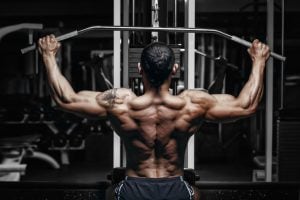
How to Get a Bigger and Stronger Back in Just 30 Days
The Ultimate Back Workout
Leg Workouts
3 Science-Backed Leg Workouts for More Hypertrophy, Power, and Strength
How to Get Bigger and Stronger Legs in Just 30 Days
This Is The Last Lower Body Workout You’ll Ever Need
The Ultimate Legs Workout
Butt Workouts
How to Get a Bigger and Rounder Butt in Just 30 Days
The Best Butt Exercises for Building Head-Turning Glutes
What’s your take on shoulder workouts? Have anything else you’d like to share? Let me know in the comments below!
Scientific References +
- Haskell CF, Kennedy DO, Milne AL, Wesnes KA, Scholey AB. The effects of L-theanine, caffeine and their combination on cognition and mood. Biol Psychol. 2008;77(2):113-122. doi:10.1016/j.biopsycho.2007.09.008
- Nobre AC, Rao A, Owen GN. L-theanine, a natural constituent in tea, and its effect on mental state.: Discovery Service for Endeavour College of Natural Health Library. Asia Pac J Clin Nutr. 2008;17(S1):167-168. doi:10.6133/APJCN.2008.17.S1.40
- Foxe JJ, Morie KP, Laud PJ, Rowson MJ, de Bruin EA, Kelly SP. Assessing the effects of caffeine and theanine on the maintenance of vigilance during a sustained attention task. Neuropharmacology. 2012;62(7):2320-2327. doi:10.1016/j.neuropharm.2012.01.020
- Bryan J. Psychological effects of dietary components of tea: caffeine and L-theanine. Nutr Rev. 2008;66(2):82-90. doi:10.1111/j.1753-4887.2007.00011.x
- Siamwala JH, Dias PM, Majumder S, et al. L-theanine promotes nitric oxide production in endothelial cells through eNOS phosphorylation. J Nutr Biochem. 2013;24(3):595-605. doi:10.1016/j.jnutbio.2012.02.016
- Kimura K, Ozeki M, Juneja LR, Ohira H. L-Theanine reduces psychological and physiological stress responses. Biol Psychol. 2007;74(1):39-45. doi:10.1016/j.biopsycho.2006.06.006
- Sugino T, Shirai T, Kajimoto Y, Kajimoto O. L-ornithine supplementation attenuates physical fatigue in healthy volunteers by modulating lipid and amino acid metabolism. Nutr Res. 2008;28(11):738-743. doi:10.1016/j.nutres.2008.08.008
- Apicella JM, Lee EC, Bailey BL, et al. Betaine supplementation enhances anabolic endocrine and Akt signaling in response to acute bouts of exercise. Eur J Appl Physiol. 2013;113(3):793-802. doi:10.1007/s00421-012-2492-8
- Lee EC, Maresh CM, Kraemer WJ, et al. Ergogenic effects of betaine supplementation on strength and power performance. J Int Soc Sports Nutr. 2010;7:27. doi:10.1186/1550-2783-7-27
- Trepanowski JF, Farney TM, McCarthy CG, Schilling BK, Craig SA, Bloomer RJ. The effects of chronic betaine supplementation on exercise performance, skeletal muscle oxygen saturation and associated biochemical parameters in resistance trained men. J strength Cond Res. 2011;25(12):3461-3471. doi:10.1519/JSC.0b013e318217d48d
- Bendahan D, Mattei JP, Ghattas B, Confort-Gouny S, Le Guern ME, Cozzone PJ. Citrulline/malate promotes aerobic energy production in human exercising muscle. Br J Sports Med. 2002;36(4):282-289. doi:10.1136/bjsm.36.4.282
- Pérez-Guisado J, Jakeman PM. Citrulline malate enhances athletic anaerobic performance and relieves muscle soreness. J strength Cond Res. 2010;24(5):1215-1222. doi:10.1519/JSC.0b013e3181cb28e0
- Kern BD, Robinson TL. Effects of β-alanine supplementation on performance and body composition in collegiate wrestlers and football players. J strength Cond Res. 2011;25(7):1804-1815. doi:10.1519/JSC.0b013e3181e741cf
- Smith AE, Walter AA, Graef JL, et al. Effects of beta-alanine supplementation and high-intensity interval training on endurance performance and body composition in men; a double-blind trial. J Int Soc Sports Nutr. 2009;6:5. doi:10.1186/1550-2783-6-5
- Derave W, Ozdemir MS, Harris RC, et al. beta-Alanine supplementation augments muscle carnosine content and attenuates fatigue during repeated isokinetic contraction bouts in trained sprinters. J Appl Physiol. 2007;103(5):1736-1743. doi:10.1152/japplphysiol.00397.2007
- Astorino TA, Rohmann RL, Firth K. Effect of caffeine ingestion on one-repetition maximum muscular strength. Eur J Appl Physiol. 2008;102(2):127-132. doi:10.1007/s00421-007-0557-x
- Cohen PA, Travis JC, Venhuis BJ. A methamphetamine analog (N,α-diethyl-phenylethylamine) identified in a mainstream dietary supplement. Drug Test Anal. 2014;6(7-8):805-807. doi:10.1002/dta.1578
- More S. Global trends in milk quality: Implications for the Irish dairy industry. Ir Vet J. 2009;62(4):5-14. doi:10.1186/2046-0481-62-S4-S5
- Fukushima M, Matsuyama F, Ueda N, et al. Effect of corosolic acid on postchallenge plasma glucose levels. Diabetes Res Clin Pract. 2006;73(2):174-177. doi:10.1016/j.diabres.2006.01.010
- Ho J-Y, Kraemer WJ, Volek JS, et al. l-Carnitine l-tartrate supplementation favorably affects biochemical markers of recovery from physical exertion in middle-aged men and women. Metabolism. 2010;59(8):1190-1199. doi:10.1016/j.metabol.2009.11.012
- Francaux M, Poortmans JR. Side effects of creatine supplementation in athletes. Int J Sports Physiol Perform. 2006;1(4):311-323. http://www.ncbi.nlm.nih.gov/pubmed/19124889. Accessed September 11, 2019.
- Bizzarini E, De Angelis L. Is the use of oral creatine supplementation safe? J Sports Med Phys Fitness. 2004;44(4):411-416. http://www.ncbi.nlm.nih.gov/pubmed/15758854. Accessed September 11, 2019.
- Poortmans JR, Francaux M. Adverse effects of creatine supplementation: Fact or fiction? Sport Med. 2000;30(3):155-170. doi:10.2165/00007256-200030030-00002
- Bassit RA, Pinheiro CHDJ, Vitzel KF, Sproesser AJ, Silveira LR, Curi R. Effect of short-term creatine supplementation on markers of skeletal muscle damage after strenuous contractile activity. Eur J Appl Physiol. 2010;108(5):945-955. doi:10.1007/s00421-009-1305-1
- Eckerson JM, Stout JR, Moore GA, et al. Effect of creatine phosphate supplementation on anaerobic working capacity and body weight after two and six days of loading in men and women. J Strength Cond Res. 2005;19(4):756-763. doi:10.1519/R-16924.1
- Lauver JD, Cayot TE, Scheuermann BW. Influence of bench angle on upper extremity muscular activation during bench press exercise. Eur J Sport Sci. 2016;16(3):309-316. doi:10.1080/17461391.2015.1022605
- Saeterbakken AH, Fimland MS. Effects of body position and loading modality on muscle activity and strength in shoulder presses. J strength Cond Res. 2013;27(7):1824-1831. doi:10.1519/JSC.0b013e318276b873
- Peterson MD, Rhea MR, Alvar BA. Applications of the dose-response for muscular strength development: a review of meta-analytic efficacy and reliability for designing training prescription. J strength Cond Res. 2005;19(4):950-958. doi:10.1519/R-16874.1
- Wernbom M, Augustsson J, Thomeé R. The influence of frequency, intensity, volume and mode of strength training on whole muscle cross-sectional area in humans. Sport Med. 2007;37(3):225-264. doi:10.2165/00007256-200737030-00004
- Schoenfeld BJ, Grgic J, Krieger J. How many times per week should a muscle be trained to maximize muscle hypertrophy? A systematic review and meta-analysis of studies examining the effects of resistance training frequency. J Sports Sci. 2019;37(11):1286-1295. doi:10.1080/02640414.2018.1555906
- Grgic J, Schoenfeld BJ, Davies TB, Lazinica B, Krieger JW, Pedisic Z. Effect of Resistance Training Frequency on Gains in Muscular Strength: A Systematic Review and Meta-Analysis. Sports Med. 2018;48(5):1207-1220. doi:10.1007/s40279-018-0872-x
- Bhasin S, Storer TW, Berman N, et al. The effects of supraphysiologic doses of testosterone on muscle size and strength in normal men. N Engl J Med. 1996;335(1):1-7. doi:10.1056/NEJM199607043350101
- Bhasin S, Woodhouse L, Casaburi R, et al. Testosterone dose-response relationships in healthy young men. Am J Physiol Endocrinol Metab. 2001;281(6):E1172-81. doi:10.1152/ajpendo.2001.281.6.E1172
- Lauver JD, Cayot TE, Scheuermann BW. Influence of bench angle on upper extremity muscular activation during bench press exercise. Eur J Sport Sci. 2016;16(3):309-316. doi:10.1080/17461391.2015.1022605
- Trebs AA, Brandenburg JP, Pitney WA. An electromyography analysis of 3 muscles surrounding the shoulder joint during the performance of a chest press exercise at several angles. J strength Cond Res. 2010;24(7):1925-1930. doi:10.1519/JSC.0b013e3181ddfae7
- Schoenfeld BJ. The mechanisms of muscle hypertrophy and their application to resistance training. J Strength Cond Res. 2010;24(10):2857-2872. doi:10.1519/JSC.0b013e3181e840f3
- Schoenfeld BJ, Peterson MD, Ogborn D, Contreras B, Sonmez GT. Effects of Low- vs. High-Load Resistance Training on Muscle Strength and Hypertrophy in Well-Trained Men. J strength Cond Res. 2015;29(10):2954-2963. doi:10.1519/JSC.0000000000000958
- SuppVersity EMG Series - M. Deltoideus, M. Infraspinatus, Supraspinatus and Teres Minor: The Very Best Exercises for Broad Shoulders and Capped Delts - SuppVersity: Nutrition and Exercise Science for Everyone. https://suppversity.blogspot.com/2011/08/suppversity-emg-series-m-deltoideus-m.html. Accessed September 11, 2019.
